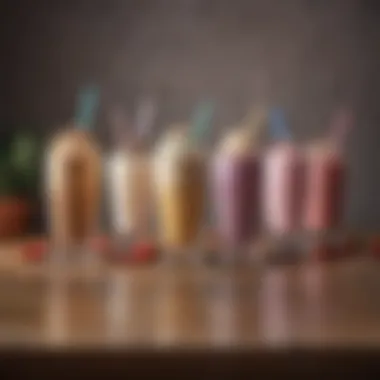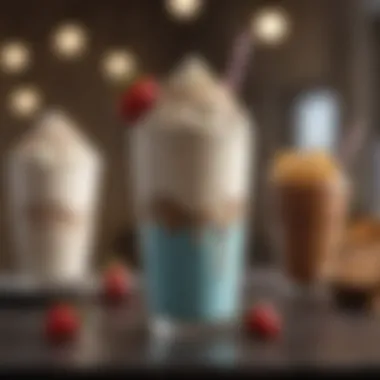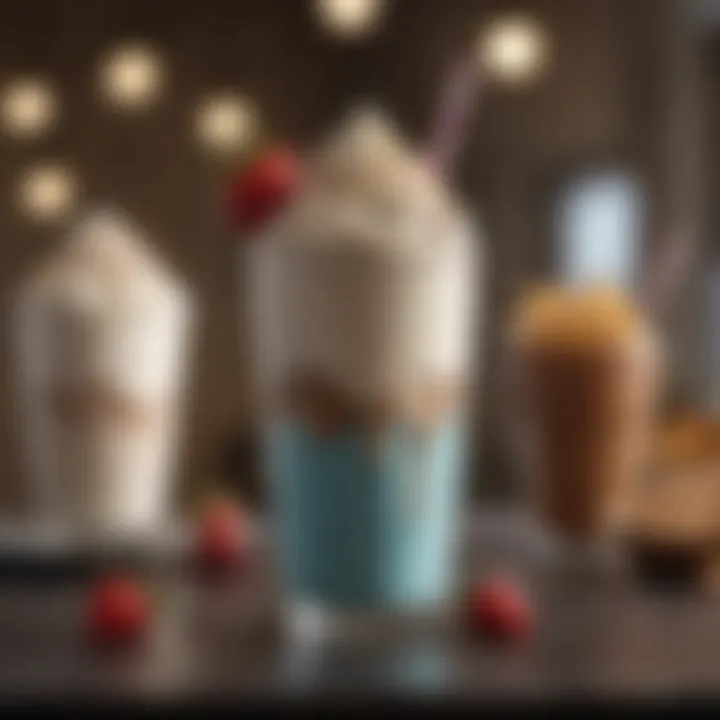Crafting the Perfect Milkshake: Essential Components


Intro
Crafting the ideal milkshake is a blend of art and science. It involves the careful selection of ingredients, the right tools, and a few techniques that transform basic components into a creamy, delightful treat. This guide serves as a roadmap for both seasoned milkshake makers and those new to the craft.
Understanding the essential elements is crucial. From the primary ingredients like ice cream and milk to the choice of flavors and optional add-ins, each decision impacts the final product. The right equipment also influences the process. A powerful blender or mixer ensures a smooth texture, while garnishes add a visual appeal.
Key Ingredients
A milkshake primarily consists of three components:
- Ice Cream: The base of any milkshake, offering rich flavor and desired creaminess. Popular flavors include chocolate, vanilla, and strawberry.
- Milk: It acts as the thinning agent, determining the consistency. Whole milk provides a richer shake, while skim or almond milk results in a lighter option.
- Flavoring: This can be syrup, fresh fruit, or even cookies. Adding these elements creates unique profiles.
In addition to these main ingredients, consider various toppings and mix-ins to enhance the experience. Whipped cream, chocolate chips, or fruit pieces can elevate the standard milkshake to something extraordinary.
Necessary Equipment
The right tools can streamline the milkshake-making process. Essential equipment includes:
- Blender or Milkshake Maker: A high-quality blender ensures uniform consistency.
- Measuring Cups: Precision in measuring ingredients impacts taste and texture.
- Serving Glasses: Aesthetic presentation matters, especially for parties or gatherings.
Investing in these tools can make the preparation smoother, ultimately enriching your milkshake experience.
Preparation Techniques
Making a milkshake requires specific preparation steps. Start by scooping your ice cream into the blender, then add milk to reach your desired consistency. Blend until smooth, and don’t hesitate to pause and scrape down the sides for an even mix.
For those looking to customize, consider adding flavorings or extra ingredients before blending. Explore combinations such as adding peanut butter or crushed cookies for added texture.
Nutritional Considerations
Milkshakes can be indulgent but they can also be tailored to healthier preferences. Using low-fat ice cream, alternative milks, or adding fruits can create nutritious options. Always be mindful of portion sizes and ingredient quality for a balanced treat.
Storage Methods
If there's leftover milkshake, proper storage is key. Store in an airtight container in the freezer. While the shake may change in texture, it will still be enjoyable after thawing. Re-blending with a bit of milk can improve consistency.
This guide provides a solid foundation for creating a perfect milkshake tailored to any occasion. Experimentation is encouraged. Embrace your creativity and enjoy the process.
Foreword to Milkshakes
The milkshake is more than just a sweet treat; it is a cultural staple and an enduring symbol of indulgence. Understanding the breadth of what constitutes a milkshake is critical when aiming to create the perfect version of this classic beverage. This section delves into what a milkshake truly is, its significance in culinary history, and its evolving role in modern diets. A clear grasp of these elements enhances not only the appreciation of milkshakes but also the ability to experiment and innovate in their preparation.
Definition and Overview
A milkshake is a creamy, sweet beverage typically made by blending ice cream, milk, and flavoring ingredients. The texture is smooth and thick, often served in a tall glass to showcase its rich composition. Common variations include the addition of syrups, candies, or fruits. Understanding this basic definition sets the foundation for exploring the various components and methods of crafting milkshakes, allowing one to appreciate both its simplicity and the potential for complexity.
Historical Context
The origins of the milkshake date back to the late 19th century, with early recipes varying significantly from what we enjoy today. Initially, milkshakes were made with milk and whiskey. By the 1920s, the introduction of ice cream transformed the drink into its current form. It became popular in diners and soda fountains across America, symbolizing youth culture and leisure. Throughout the decades, the milkshake adapted to changing tastes and dietary preferences, cementing its place in culinary traditions. An understanding of this historical context highlights how the milkshake has shaped and been shaped by societal trends, influencing everything from flavors to dietary restrictions.
Understanding the journey of the milkshake from its roots to contemporary variations helps enthusiasts to appreciate the versatility and cultural significance of this delightful beverage.
Core Ingredients
Core ingredients are the foundation of any milkshake, determining its flavor, texture, and overall appeal. The right combination of these essentials can elevate a simple milkshake into a delightful experience. Understanding the nuances of each component is crucial for crafting a satisfying drink. The three primary ingredients include ice cream, milk, and flavorings/add-ins. Selecting the best options not only enhances taste but also affects the nutritional profile of the milkshake, making it essential to consider preferences and dietary needs.
Primary Ingredient: Ice Cream
The primary ingredient for any milkshake is undoubtedly ice cream. It provides the creamy texture and sweetness that characterizes this beloved beverage. Different varieties of ice cream can yield varying results, influencing both taste and consistency.
Varieties of Ice Cream
Ice cream comes in multiple forms, each contributing different flavors and textures to milkshakes. Common varieties include vanilla, chocolate, and strawberry. What's crucial is the base composition, whether it's dairy, non-dairy, or even gelato. For example, French vanilla offers a richer taste due to its egg yolk content, whereas sorbets provide a fruit-forward, lighter alternative. Each variety plays a distinct role, impacting sweetness and creaminess.
The key characteristic of different ice cream flavors is how they can enhance or overshadow other ingredients. Chocolate ice cream can dominate a milkshake, while a milder flavor like vanilla allows more flexibility in terms of add-ins. Notably, richness may be a beneficial feature for those seeking indulgence, but it can also limit options for lighter variations when targeting healthier preferences.


Choosing Quality Ice Cream
When selecting ice cream for milkshakes, quality matters. High-quality ice cream typically contains natural ingredients and less air, leading to a denser and creamier product. This density is particularly advantageous, enhancing the milkshake's viscosity and richness.
A notable advantage of choosing quality ice cream is its flavor authenticity. Natural flavors can make a significant difference in taste and satisfaction. Moreover, brands that use high percentages of cream generally produce better milkshakes. However, it may come with a higher price tag, making it a consideration for budget-conscious individuals.
Liquid Base: Milk
Milk serves as the liquid base for milkshakes, impacting both texture and consistency. Its role is crucial, as the right balance between ice cream and milk can determine how thick or fluid the milkshake becomes.
Dairy Milk Options
Dairy milk options typically include whole, 2%, or skim milk. Each choice has a distinct impact on the ultimate texture. Whole milk provides a rich and creamy mouthfeel, making it a preferred choice for classic milkshakes. In contrast, skim milk can create a thinner shake.
The key characteristic of dairy milk is its protein content, which can contribute to the overall creaminess. Protein-rich milk enhances the milkshake's ability to hold air, resulting in a thicker consistency. A notable advantage of using dairy options is the availability of numerous fat percentages, allowing for tailored choices based on dietary preferences.
Non-Dairy Alternatives
As the demand for plant-based diets increases, non-dairy milk alternatives have gained popularity. Options such as almond milk, soy milk, and oat milk are commonly used in milkshakes. Each contributes a different flavor profile and texture.
A key characteristic of non-dairy alternatives is their variability in creaminess. For instance, oat milk tends to be creamier than almond milk, making it more suitable for milkshakes. This flexibility makes non-dairy alternatives a beneficial option for those with lactose intolerance or dietary restrictions.
However, it is essential to consider that some non-dairy options may have added sugars or flavors that can affect the milkshake's overall taste. Therefore, selecting unsweetened or organic varieties is advisable to maintain control over the final product's flavor.
Flavorings and Add-Ins
Flavorings and various add-ins add complexity to milkshakes, transforming standard recipes into unique experiences. Each ingredient, whether it be extracts, fruits, or chocolate, brings its distinct flavors and textures to the mix.
Extracts
Extracts like vanilla, almond, or mint can significantly enhance the flavor profile of a milkshake. Using pure extracts provides a depth that artificial flavoring cannot replicate. Extracts serve as a concentrated source of flavor, and just a few drops can change the drink's experience.
The key characteristic of extracts is their potency. For example, vanilla extract is a staple that complements many flavors without overpowering them. The advantage of including extracts is the ease with which flavor can be enhanced without extensive modification to the basic recipe.
Fruits
Fresh or frozen fruits can radically alter the taste and nutrition of milkshakes. Strawberries, bananas, and mangoes can add natural sweetness and fiber. The full fruit complements the creaminess of ice cream and milk, creating a balanced beverage.
The key characteristic of fruits is their nutritional value. Unlike sugary syrups, fruits provide vitamins and minerals, making them a healthier addition. However, their disadvantage can be the need for blending time or texture inconsistency. Some fruits may create a pulp that some may find unappealing.
Chocolate and Syrups
Chocolate syrup is often a classic addition to milkshakes, enhancing the flavor and richness. Whether used as a base ingredient or as a topping, it provides a recognizable and satisfying taste.
The key characteristic of chocolate and syrups is their flexibility. They can be used to create various flavors, from traditional chocolate shakes to unique combinations like chocolate-peanut butter. However, an overabundance can lead to a disadvantage of excessive sweetness, potentially overpowering other flavors in the shake.
Necessary Equipment
Creating the perfect milkshake is not merely about the ingredients. The right equipment plays a vital role in achieving that smooth, creamy texture and delicious flavor. Without appropriate blending devices and serving containers, even the highest quality ingredients may not yield the desired results. This section will detail the essential equipment needed for crafting milkshakes effectively.
Blending Devices
Blending devices serve as the heart of milkshake preparation. They are responsible for mixing the ice cream, milk, and any additional flavorings uniformly. Having the right type of blender or mixer can make the process more efficient and yield better results.
Blender Types
When it comes to blenders, there are several kinds available on the market. Each type offers different features and functionalities, which can enhance the milkshake-making experience.
- Countertop Blenders: These are powerful machines equipped with high-speed motors. They can blend ingredients quickly and efficiently, making them a preferred choice for many enthusiasts. The robust capabilities allow them to crush ice and create smooth mixtures.
- Variable Speed Blenders: These blenders offer the ability to control speed settings. This helps in achieving the desired consistency without over-blending the ingredients. Such flexibility is beneficial when you want to incorporate chunky add-ins like fruits or cookies.
While countertop blenders are popular due to their versatility, they come with a higher price tag and may occupy more kitchen space. If space and budget are concerns, one could consider a more compact blender, although it might lack the power of larger models.
Handheld Mixers
Handheld mixers provide a convenient alternative to bulky blenders. They can be easily stored and are less cumbersome to handle.
- Ease of Use: A prominent advantage is their straightforward interface. Most handheld mixers come with simple speed settings. This provides control over the blending process, allowing for a gradual incorporation of ingredients.
- Versatile: While they are not as powerful as traditional blenders, handheld mixers can effectively blend smaller quantities. This can be ideal for individuals who rarely make large batches of milkshakes.


However, the downside includes potential difficulty blending thicker mixtures thoroughly. If a dense milkshake is desired, a handheld mixers's limited power may not achieve the desired texture.
Serving Containers
After blending, the next consideration is how to serve the milkshake. The choice of serving containers impacts both presentation and enjoyment.
Types of Glassware
The choice of glassware can elevate the milkshake experience. Different types of cups or glasses not only enhance aesthetics but can also influence how the milkshake is enjoyed.
- Classic Milkshake Glasses: These are tall and often curved, providing ample space for whipped cream or garnishes. Their design promotes enjoyment, as the drink can be sipped comfortably.
- Mason Jars: These have become popular for their rustic appeal. People enjoy using them for milkshakes as they can hold large servings. Moreover, their wide mouth allows for easy loading of toppings or add-ins.
The classical milkshake glasses enhance visual appeal but can be more fragile. In contrast, mason jars are more durable but may not convey the same level of sophistication.
Eco-Friendly Options
In today’s environmentally conscious society, eco-friendly options for serving containers have gained traction.
- Biodegradable Cups: Made from compostable materials, these cups maintain functionality without contributing significantly to pollution. They ensure that you can enjoy a tasty treat while being kind to the environment.
- Reusable Straws: To complement these cups, many are opting for reusable straws. They not only reduce plastic waste but often enhance the drinking experience.
While eco-friendly options are commendable, they may sometimes come at a higher cost. Additionally, their availability might be limited, depending on local resources.
In summary, selecting the necessary equipment for making a milkshake involves careful consideration of both blending devices and serving containers. Each plays a significant role in ensuring that the final product meets expectations.
Preparation Techniques
Preparation techniques for making milkshakes are fundamental to achieving a delicious and satisfying end product. Understanding these techniques can enhance not only the flavor but also the texture and overall experience of consuming the milkshake. This section will address various aspects of preparation, such as the crucial steps in the process and best practices that ensure optimal results.
Basic Steps of Making a Milkshake
Creating a milkshake requires a systematic approach to ensure that every ingredient is properly executed. Here are the basic steps:
- Select the Ingredients: Start by choosing your favorite ice cream flavor and liquid base. The classic choice is dairy milk, but various non-dairy alternatives are also available.
- Measure the Ingredients: Generally, a good ratio is about two scoops of ice cream for every half cup of milk. However, this can be adjusted based on personal preference for thickness.
- Combine in Blender: Place the ice cream and milk into the blender. If you are using any additional flavorings, such as syrups or fruits, is the time to add them.
- Blend Thoroughly: Start blending at a low speed and gradually increase to a higher speed. This helps in achieving a smooth consistency without splattering.
- Check Consistency: Pause the blending process to check the thickness. If the shake seems too thick, add a bit more milk. If it’s too thin, consider adding more ice cream.
- Serve Immediately: Pour the milkshake into your pre-chilled serving glass. Serve it right away for the best experience, as it will be at its freshest.
Incorporating these steps will lead you to create a delightful milkshake that opinions of taste can enhance, making it popular for casual treats or social gatherings.
Best Practices for Blending
Blending perfectly is essential for the ideal milkshake. Follow these best practices to enhance your preparation experience:
- Use a High-Quality Blender: Invest in a dependable blender that can handle ice cream and other thick ingredients without strain. Brands like Vitamix and Ninja are renowned for their performance in this aspect.
- Don’t Overfill: Consider not overfilling the blender, as the contents need room to mix adequately. It is better to blend in batches if you're making multiple shakes.
- Start Slow: Beginning on a low speed prevents spilling and allows for even mixing of the ingredients. Gradually increase speed to achieve the desired consistency.
- Utilize Pulse Option: If your blender has a pulse option, use it. Pulsing can help incorporate ingredients that settle at the bottom without turning everything into pure liquid too soon.
- Incorporate Air: Aim to blend long enough to incorporate a bit of air, which will improve the texture and make your shake feel more voluminous.
Following these techniques can vastly improve the quality of your milkshake. Skills honed through preparation and blending will make a significant difference in the enjoyment of this classic beverage.
Customization and Variations
Customization and variations are crucial when crafting a milkshake. They allow individuals to tailor their drinks to specific tastes, dietary needs, or cultural preferences. This facet not only enhances enjoyment but also expands the accessibility of milkshakes to a broader audience. As milkshakes evolve in popularity, the options for personalization ensure that they remain relevant and appealing to diverse palates.
Healthier Alternatives
Low-Sugar Options
Low-sugar options are an important topic when discussing healthier milkshakes. They help cater to individuals who are health-conscious or following specific dietary regimens. These variations often utilize sweeteners like stevia or erythritol that have minimal impact on blood sugar levels. This characteristic makes them beneficial for those managing diabetes or looking to reduce caloric intake.
One unique feature of low-sugar milkshakes is their ability to maintain flavor. With careful selection of ingredients, it is possible to create a delicious drink that satisfies sweet cravings without the excess calories from sugar. However, it is essential to consider the taste preferences of the audience, as some may find low-sugar alternatives lacking in sweetness compared to traditional recipes.
Protein-Enhanced Milkshakes
Protein-enhanced milkshakes provide a nutritious alternative that is fulfilling and energizing. Popularity stems from the growing interest in fitness and well-being, making these shakes ideal for post-workout recovery or as a meal replacement. The incorporation of protein powder, Greek yogurt, or nut butters increases the shake's nutritional profile significantly.
The key characteristic of protein-enhanced versions is their ability to promote muscle repair and satiety. A unique feature is their versatility; they can easily be customized with various flavors such as vanilla, chocolate, or decadent peanut butter. Disadvantages can include a chalky texture if low-quality protein powders are used. Additionally, individuals with dietary restrictions should ensure that the protein sources selected are suitable for their needs.
Cultural Flavors
International Ingredients
International ingredients offer a rich opportunity for expanding the milkshake's flavor profile. Incorporating elements from different cultures enhances the drink's uniqueness and can introduce consumers to exotic tastes. Ingredients such as matcha from Japan, dulce de leche from Latin America, or cardamom from Indian cuisine can bring distinctive flavors to the milkshake realm.


These options allow enthusiasts to experiment and learn about various global culinary practices, enriching their milkshake creations. One potential downside is accessibility; some international ingredients may not be readily available in all regions, which can limit experimentation.
Regional Recipes
Regional recipes highlight local traditions and flavors, showcasing the diversity of methodologies that can be used to create milkshakes. Each region may have specific ingredients or techniques that reflect their cultural heritage. For instance, key lime pie milkshakes can be found in the southern United States while Mexican horchata milkshakes are another choice reflecting authentic flavors.
This characteristic allows consumers to experience a sense of place or nostalgia in their drink. Unique aspects of regional recipes are often tied to holiday seasons or local celebrations, adding significance to the preparation and consumption. A potential drawback could be that these recipes may require specialized ingredients or preparation methods that are not familiar to all home cooks.
Nutritional Considerations
Nutritional considerations are vital in understanding how milkshakes can fit into various dietary preferences and health goals. A well-crafted milkshake can offer both enjoyment and nourishment, but it is essential to consider its caloric content and potential dietary restrictions. Knowledge about these aspects allows for better choices that align with individual health requirements and personal tastes.
Caloric Content
The caloric content of a milkshake varies significantly based on its ingredients. Using full-fat ice cream, whole milk, and sugary syrup can lead to a high-calorie beverage. A standard milkshake can range from 300 to 800 calories per serving, depending on these factors. Therefore, understanding how to balance flavors while managing calories is crucial.
When crafting a milkshake for specific diets, reducing caloric content can be achieved through methods like choosing low-fat dairy options or using alternative sweeteners. Additionally, being mindful of portion sizes can help maintain a manageable caloric intake. This approach ensures enjoyment without excessive indulgence.
Dietary Restrictions
Gluten-Free
Gluten-free milkshakes are increasingly relevant as many individuals adopt this lifestyle. A gluten-free option minimizes the risk for those with celiac disease or gluten sensitivity. The basic ingredients of a milkshake, including ice cream and milk, are naturally gluten-free. However, the potential for cross-contamination arises if flavored syrups or toppings contain gluten.
The key characteristic of gluten-free milkshakes is that they remain accessible and delicious for everyone. Many modern ice creams and toppings are now labeled gluten-free, making it easier for consumers to find appropriate options. This inclusivity plays a significant role in making milkshakes a popular choice among diverse dietary needs.
Lactose Intolerance
Lactose intolerance presents another layer of consideration for milkshake enthusiasts. Many individuals experience difficulty digesting lactose, the sugar found in milk products. For them, traditional milkshakes can lead to discomfort. Therefore, understanding lactose intolerance is significant in crafting a universally appealing milkshake.
A crucial characteristic of catering to lactose intolerance is the availability of lactose-free products. Lactose-free milk and ice cream provide similar flavors and textures without the negative effects associated with lactose consumption. Moreover, creating a lactose-intolerant friendly milkshake is beneficial, as it opens up the experience to a broader audience who can enjoy this treat without worry.
Through careful ingredient selection, nutritional considerations ensure that milkshakes can cater to diverse preferences while remaining enjoyable.
Storage and Serving Suggestions
In the realm of milkshakes, the way you store and present the beverage contributes significantly to the overall experience. While it may seem trivial, proper storage ensures the texture and flavor stay intact. Presenting milkshakes at the right moment also enhances enjoyment. Understanding these aspects can make the difference between a good milkshake and a memorable one.
Storing Leftover Milkshake
Leftover milkshake can often be a source of disappointment if not handled correctly. Ideally, milkshake should be consumed immediately to enjoy its peak flavor and texture. However, life sometimes gets in the way, and leftover milkshake may be unavoidable. If you find yourself with surplus milkshake, consider these options:
- Refrigeration: Store leftover milkshake in an airtight container, limiting exposure to air. This measure helps prevent spoilage and retains freshness.
- Freezing: For longer storage, place the milkshake in a freezer-safe container. However, be aware that freezing can alter the texture, making it grainy upon thawing.
When drinking the refrigerated milkshake, it should be stirred or blended again. This helps restore some original consistency.
Best Time to Serve
Timing is crucial when it comes to serving milkshakes. The best moment to serve a milkshake is immediately after preparation. This allows the consumer to experience the rich creaminess and complete flavor profile. Here are some considerations for optimal serving:
- Temperature: Serve milkshakes cold. If possible, chill glassware beforehand. This added touch keeps the milkshake colder for longer.
- Presentation: Utilize attractive glassware or mason jars to serve milkshakes. A visually appealing setup enhances the overall drinking experience.
In social settings or parties, having a variety of milkshake options can cater to different tastes. Providing a dazzling selection of flavors can create an memorable experience for your guests.
"The enjoyment of a milkshake comes not only from its taste but also from its presentation and the moment it is served."
In summary, understanding how to store leftover milkshake ensures that you minimize waste while still enjoying your creation. Paying attention to the best time to serve enhances the overall experience, making each sip satisfying and delightful.
End
Milkshakes are more than just a delightful treat; they encapsulate creativity and personal expression in culinary form. In this article, we have explored various components essential for crafting these beverages, from core ingredients to preparation techniques. Understanding the key elements involved in milkshake production is vital for anyone who wishes to create a satisfying drink that can cater to varied preferences and dietary requirements.
Making a perfect milkshake requires thoughtful selection of ingredients. Quality ice cream serves as the foundation, while the right milk choice enhances texture and flavor. Furthermore, exploring diverse flavorings and add-ins can elevate the overall experience. Knowing how to customize these elements allows individuals to make decisions that align with personal taste and nutritional desires.
The significance of employing the right equipment cannot be overstated. Whether using a high-performance blender or a simple handheld mixer, the tools influence the consistency of the final product. Moreover, effective storage methods ensure that leftovers do not go to waste, preserving both taste and texture for later enjoyment.
From a nutritional standpoint, consciousness about caloric content and dietary restrictions—such as gluten-free and lactose-intolerant options—can transform a standard indulgence into a guilt-free or health-conscious choice. This flexibility serves as an invitation for those who are more cautious about their diet but still desire a delicious experience.
Ultimately, crafting a milkshake is a process that allows for both technical mastery and artistic flair. It invites experimentation, encourages innovation in flavors, and serves as a gateway to explore dietary trends. As you navigate the world of milkshakes, the knowledge and insights garnered from this guide empower you to create blends that are not only enjoyable but also resonate with your personal or social context.
"Crafting a milkshake allows one not just to create a drink, but to express a unique palate."
In summary, understanding these elements grants mastery over the art of milkshake making, inspiring creativity while ensuring an alignment with personal tastes and nutritional values.



